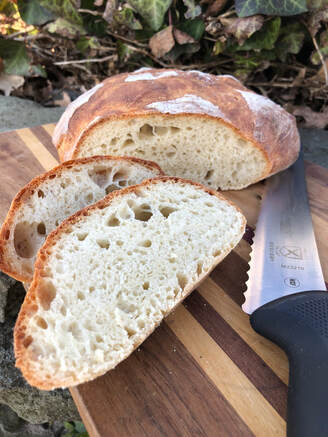Donna's Daily Dish
Inspiring people to create every day recipes
 Lately I have been interested in bread baking. I like a crusty loaf with a light and slightly airy crumb structure. A few weeks ago, I viewed a video with Mark Bittman of The New York Times and Jim Lahey, of Sullivan Street Bakery, where Mr. Lahey demonstrated his no knead bread recipe. It looked very easy; so, I gave it a go. For his recipe you’ll need all-purpose flour or bread flour, instant yeast, kosher salt and cornmeal. If you watch the video with Jim and Mark, you’ll notice that Jim starts with 3 cups of all-purpose flour and 1-1/4 teaspoon of salt. In the adapted version by Mark Bittman, his recipe uses 3-1/3 cups of flour and 2 teaspoons of salt, however, I followed the recipe from the video. In the video, after mixing the dough by hand, you’ll see some oil has been added to the bowl; I didn’t notice this part earlier. Jim Lahey baked his bread in LeCreuset Dutch Oven, I used a Lodge cast iron Dutch oven. Although I followed his recipe, my end result didn’t achieve the same crusty exterior. I don’t know if the surface of the Lodge cast iron played a part or I didn’t apply enough flour over the top of the bread during the second rise. A few weeks have gone by since I made Jim Lahey’s recipe, that I felt confident enough to try again. However, this time I tried a recipe that my friend Lorraine shared with me. The recipe she follows is from the book “Artisan Bread in Five Minutes a Day.” Although it’s been years since I had a loaf she baked, I remember how wonderful it tasted. This is also a no-knead recipe except this one is baked on a baking stone and has a preheated pan on the bottom shelf to which you’ll add water for creating steam during baking. What a difference in recipes! My husband and I loved this loaf of bread. The bread had a crusty exterior with a well-form crumb structure that didn’t fewer air pockets. I let the bread cool before cutting a slice for myself and slathering with butter. It was delicious, it had nice flavor and a nice crumb for buttering. Although the full recipe makes four 1-pound loaves, I made half. However, the next time I’ll make a full recipe. The dough can be refrigerated for 14 days or frozen. Keeping it for 14 days will continue the maturation. The recipe also suggests that after emptying your bucket, don’t wash it, but make another batch in the same container. If there’s some dough stuck on the sides, leave it, it will give you a head start on sour dough flavor. The Master Recipe: Boule (Artisan Free-Form Loaf) “Artisan Bread in Five Minutes a Day: The Discovery That Revolutionizes Home Baking,” by Jeff Hertzberg M.D., Zoë François Makes four 1-pound loaves. The recipe is easily doubled or halved. 3 cups lukewarm water 1 1/2 tablespoons granulated yeast (2 packets) 1 1/2 tablespoons kosher salt or other coarse salt 6 1/2 cups unsifted, unbleached, all-purpose white flour, measured with the scoop-and-sweep method Cornmeal for pizza peel
No-Knead Bread Recipe from Jim Lahey Adapted by Mark Bittman, The New York Times/Cooking Time: 1 hour 30 minutes, plus about 20 hours resting time “Here is one of the most popular recipes The Times has ever published, courtesy of Jim Lahey, owner of Sullivan Street Bakery. It requires no kneading. It uses no special ingredients, equipment or techniques. And it takes very little effort — only time. You will need 24 hours to create the bread, but much of this is unattended waiting, a slow fermentation of the dough that results in a perfect loaf. (We've updated the recipe to reflect changes Mark Bittman made to the recipe in 2006 after publishing and receiving reader feedback. The original recipe called for 3 cups flour; we've adjusted it to call for 3⅓ cups/430 grams flour.)” Yield: One 1½-pound loaf 3⅓ cups/430 grams all-purpose or bread flour, plus more for dusting Generous ¼ teaspoon/1-gram instant yeast 2 teaspoons/8 grams kosher salt Cornmeal or wheat bran, as needed
Index
0 Comments
Leave a Reply. |
|
||||||||||||